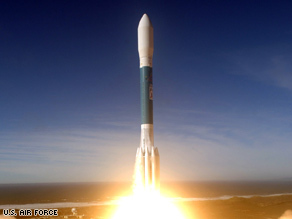The Pentagon said the window of opportunity to strike the 5,000-pound satellite opened Wednesday, when the space shuttle Atlantis landed in Florida. The Pentagon wanted to be sure the shuttle would not be struck by any debris from a destroyed satellite.
But earlier the official said conditions had to be perfect, and that was not the case Wednesday with swells in the Pacific Ocean west of Hawaii running slightly higher than Navy would like.

|
| ©U.S. Air Force |
| A Delta II rocket lifts off, carrying a reconnaissance satellite that failed hours later. |
The United States plans to spend up to $60 million to try to destroy the satellite even though there is only a remote possibility the satellite could fall to Earth, survive re-entry and spew toxic gas in a populated area, said James Jeffrey, deputy national security adviser.
"The regret factor of not acting clearly outweighed the regret factor of acting," he said.
The Chinese military destroyed an aging weather satellite last year, prompting questions about whether the United States is merely flexing its muscle to show an economic and military rival that it can destroy satellites, too. Jeffrey denied that when a reporter asked him about it this week.
"This is all about trying to reduce the danger to human beings," he said.
In 1989, a U.S. fighter jet destroyed a U.S. satellite by firing a modified air-to-air missile into space from an altitude of 80,000 feet. That adds to evidence that the U.S. is acting Wednesday strictly to guard against the prospect of a potential disaster, said Gen. James Cartwright, vice-chairman of the U.S. Joint Chiefs of Staff.
Without intervention, officials say, the satellite would fall to Earth on its own in early March. However, since it malfunctioned immediately after it was launched in December 2006, it has a full tank -- about 1,000 pounds -- of frozen, toxic hydrazine propellant.
Authorities said the fuel tank likely would survive re-entry and could disperse harmful or even potentially deadly fumes over an area the size of two football fields. Hydrazine is similar to chlorine or ammonia in that it affects the lungs and breathing tissue.
The goal is to strike the satellite in low orbit, just before it re-enters the Earth's atmosphere, at an altitude of about 150 miles. The missile will not carry a warhead. The idea is to blast the satellite apart on impact so that the hydrazine tank explodes.
The smaller debris would be more likely to burn up in the atmosphere. Most of the debris would re-enter the atmosphere within hours of impact, NASA Administrator Michael Griffin has said.
The military timed its shoot-down attempt so that resulting debris will tumble into the atmosphere and not interfere with other satellites, said Christina Rocca, a U.S. diplomat and expert on disarmament. Her comments were included in an online United Nations report on this month's Conference on Disarmament in Geneva, Switzerland.
The military also has timed its efforts to minimize the chances that debris will hit populated areas. But the United States is "prepared to offer assistance to governments to mitigate the consequences of any satellite debris impacts on their territory," according to a report of Rocca's remarks on the Web site of the Geneva office of the U.N.
If the satellite is not destroyed, she said, it is expected to make an "uncontrolled re-entry into the Earth's atmosphere" on or about March 6.
President Bush made the decision to shoot the satellite down after consulting with several government and military officials and aerospace experts, Jeffrey said earlier in February.
One Pentagon official said that since early January, a Navy team including 200 industry experts and scientists has been working furiously to modify the Aegis air-defense missile system so it could shoot down the satellite. Among the team's challenges was modifying the sensors designed to detect the heat from an incoming warhead, as the satellite will be much cooler.
The Lake Erie, an Aegis-equipped cruiser, was expected to be joined in the Pacific by two destroyers, the USS Decatur and the USS Russell.
The Lake Erie was slated to fire the missile, while the Decatur fed the trajectory to the Erie. The Russell was to serve as the Decatur's backup, authorities have said.
The satellite and the missile were expected to head toward each other at about 22,000 mph. The satellite is about the size of a school bus, authorities have said; the missile was to be aimed at its fuel tank, which is about 3 or 4 feet long.
Authorities said earlier that the missile would release a "kinetic kill vehicle," enabling it to "see" the satellite and adjust its course toward it if necessary, officials have said.
In January 2007, China used a land-based missile to destroy a 2,200-pound satellite that was orbiting 528 miles above the Earth. The impact left more than 100,000 pieces of debris orbiting the planet, NASA estimated -- 2,600 of them more than 4 inches across. The U.S. agency called the breakup of the Fengyun-C satellite the worst in history.
China, however, is among a host of countries who are monitoring the U.S. satellite kill shot. It is "highly concerned" and has expressed its reservations to the United States, according to a report in the state-run Xinhua news agency.



When have they ever cared about human beings? And to spend $60 million as well. It gave they a chance to play with shooting down things in space whether it be satellites or asteroids.